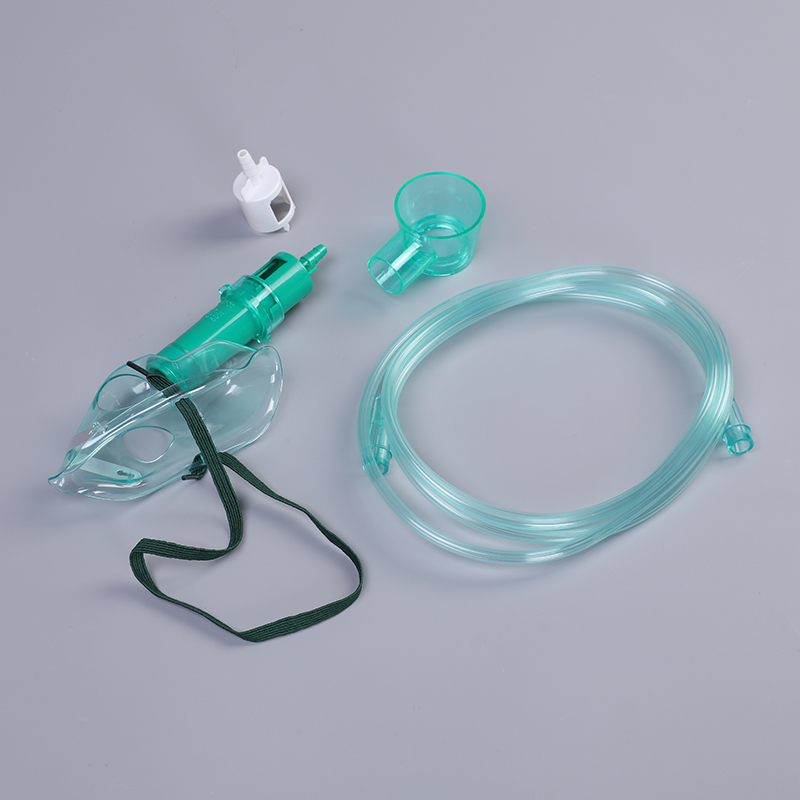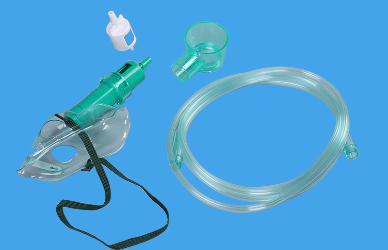-



Venturi Masks Vs. Other Oxygen Delivery Systems: What Healthcare Providers Need To Know
Views: 0 Author: Site Editor Publish Time: 2025-06-16 Origin: Site

Infection control is at the forefront of modern hospital practice, and nowhere is this more critical than in respiratory care. Oxygen delivery devices—ranging from simple nasal cannulas to advanced high-flow systems—are indispensable tools but also potential vectors for hospital-acquired infections (HAIs). Selecting the right device for each clinical scenario involves balancing precise oxygen dosing with robust infection-prevention protocols. Venturi masks, leveraging the Venturi effect for fixed FiO₂ delivery and designed for single-patient use, address both imperatives: they deliver accurate oxygen concentrations while minimizing cross-contamination risks.
COPD Exacerbation: Avoiding Hypercapnia with Venturi vs. Cannula
Clinical Context & Infection Risks
Patients experiencing a COPD exacerbation often require supplemental oxygen to correct hypoxemia, but over-oxygenation can suppress their respiratory drive, leading to CO₂ retention and respiratory acidosis. Nasal cannulas, while comfortable and widely used for low-flow oxygen, provide highly variable FiO₂ depending on patient breathing patterns and flow rates—typically between 24% and 44%. This variability poses two challenges: clinicians cannot reliably titrate to precise targets, and improper cannula placement increases the risk of skin breakdown and bacterial colonization at nares and surrounding facial skin.Venturi Mask Advantages
Fixed FiO₂ Delivery: Color-coded jets guarantee specific FiO₂ (e.g., 24%, 28%, 35%), maintaining oxygen levels within ±5% of set targets regardless of inspiratory flow.
Disposable Design: Single-use masks eliminate the need for recurrent cleaning or sterilization, cutting down on cross-infection between patients, particularly critical in immunocompromised COPD populations.
Comfort & Fit: Ergonomic soft seals reduce pressure injuries and maintain a secure interface, lowering the risk of leakage and bacterial entry points compared to nasal cannulas that irritate the nasal mucosa over time.
Practical Tip
For stable COPD exacerbations, start with a 24% Venturi jet (blue) at 2–4 L/min, monitor SpO₂ aiming for 88–92%, and adjust to the next higher FiO₂ adapter only if targets aren’t met—thus avoiding the CO₂ retention associated with uncontrolled high-flow cannulas.Acute Heart Failure & Pulmonary Edema: High-Flow Nasal Cannula vs. Venturi
Clinical Context & Infection Considerations
In acute heart failure with pulmonary edema, rapid correction of hypoxemia can alleviate dyspnea and reduce myocardial workload. High-flow nasal cannulas (HFNC) can deliver up to 100% FiO₂ at flows of 30–60 L/min, generating low levels of positive airway pressure. However, HFNC systems involve complex reusable circuits and humidifiers that require meticulous disinfection; any lapse can seed pathogens into condensate reservoirs, fueling HAIs.Venturi Mask Role
Moderate FiO₂ Precision: For patients needing moderate oxygen support (<60% FiO₂), Venturi masks offer fixed, reliable oxygen without the complexity of HFNC setup.
Simplified Infection Control: With no humidification chamber or intricate tubing loops, Venturi masks—packaged sterile and used once—bypass the risk of biofilm formation in reusable humidifiers.
Rapid Deployment: Color-coded adapters enable instant FiO₂ targeting in high-acuity settings, matching the speed of HFNC initiation but with fewer infection vectors.
Clinical Workflow
In the triage or emergency bay, use a 40% Venturi mask (red jet) at 8–10 L/min to stabilize SpO₂ in mild to moderate pulmonary edema. If higher pressure support is required, escalate to HFNC under strict humidifier‐maintenance protocols and enhanced hygiene checks.Post-Operative Care: Comfort and Compliance Considerations
Clinical & Infection Challenges
Post-operative patients often emerge with compromised respiratory mechanics due to anesthesia, pain, or sedation. Comfort is paramount to ensure compliance with oxygen therapy, yet reusable masks and cannulas may harbor pathogenic bacteria if disinfection protocols are rushed between high patient turnovers.Why Venturi Masks Excel
Ergonomic Mask Body: Soft, latex-free seals and contoured designs distribute pressure evenly across the face, reducing discomfort and the temptation to remove the mask.
Anti-Fog Venting: Integrated vents prevent condensation build-up, improving patient visibility and decreasing face-mask microclimate that fosters bacterial growth.
Disposable Convenience: Each post-op patient receives a brand-new mask, sidestepping the risk of residual blood or secretion contaminants from previous users.
Best Practices
Select a 28% or 35% Venturi jet based on intraoperative blood gas analysis and initial SpO₂ readings.
Educate patients on the mask’s function, emphasizing its comfort features to improve adherence.
Coordinate with sterile processing to ensure timely removal and disposal, preventing environmental contamination in recovery units.
Pediatric and Neonatal Use: Mask Fit, Dead Space, and Alternative Interfaces
Sensitivity to Infection & Gas Exchange
Children, especially neonates, have higher respiratory rates and lower tidal volumes, making FiO₂ precision and minimal dead space critical. Moreover, pediatric airways and skin are more susceptible to injury and colonization by pathogens.Pediatric Venturi Mask Attributes
Size-Specific Masks: Tailored contours reduce dead space, ensuring each breath reflects the intended FiO₂.
Gentle Seals: Soft elastomer materials reduce pressure marks and microbial trapping in skin folds.
Single-Use Adapters: Color-coded jets of 24% and 28% FiO₂ help prevent hyperoxia-related retinopathy in neonates.
Alternative Interfaces
While nasal prongs are common for infants, they carry a risk of nasal ulceration and microbial colonization in the nares. Pediatric Venturi masks offer a mask‐based alternative that balances precise oxygen delivery with reduced skin and mucosal trauma.
Transport and Ambulance Settings: Portability and Setup Speed
Challenges En Route
Oxygen therapy during patient transport—within hospitals or by ambulance—demands simplicity and rapid assembly. Reusable systems require cleaning stations that are unavailable in transit, raising contamination concerns.Venturi Mask Advantages in Transit
Lightweight, Single-Packaging: Sterile pouches open quickly, and color-coded jets eliminate guesswork.
Minimal Accessories: No bulky humidification units or lengthy tubing loops to tangle or contaminate.
Consistent FiO₂ Despite Motion: The Venturi effect is unaffected by vehicle movement, ensuring stable oxygen concentrations on bumpy roads.
Operational Tip
Equip transport teams with Venturi mask kits (including adult and pediatric sizes plus all five color jets) in grab bags. Conduct quarterly drills to practice jet changes under time pressure, reinforcing infection-control steps such as glove changes and immediate mask disposal.
Case Study Examples: ZhenFu Venturi Masks in Use
Case Study 1: Urban ICU Workflow Optimization
An 18-bed urban ICU replaced reusable mask systems with ZhenFu single-use Venturi masks. Over six months, the unit reported a 35% reduction in respiratory device‐related infections and a 20% decrease in setup time per patient, as nurses no longer needed to sterilize or leak-test masks.Case Study 2: COPD Clinic Protocol Enhancement
A pulmonology outpatient clinic integrated Venturi masks into their exacerbation-management protocols. Patients received 24% or 28% FiO₂ masks for home-use demonstrations, significantly improving their understanding of oxygen titration. Clinic-documented adherence rose from 60% to 85%, and no device‐related skin infections were reported.Case Study 3: Neonatal Transport Success
A regional neonatal transport team adopted ZhenFu’s pediatric Venturi masks and reported smooth FiO₂ control during inter‐hospital transfers. The masks’ minimal dead space and secure fit reduced desaturation episodes by 30%, and single-use packaging eliminated concerns about microbial transmission in the tight confines of transport incubators.

Conclusion:
Hospital infection control and precise respiratory support need not be mutually exclusive. Venturi masks provide a robust solution—precise FiO₂ regulation through the Venturi effect, combined with single-use, sterile designs that dramatically lower cross-contamination risks. Whether managing COPD exacerbations, acute heart failure, post-operative recovery, pediatric care, or patient transport, Venturi masks enable clinicians to deliver targeted therapy swiftly and safely.
ZhenFu Group leverages ISO-certified manufacturing, medical-grade materials, and CNC-machined precision to engineer Venturi masks that healthcare providers worldwide depend on. From color-coded jets that simplify titration to ergonomic, hypoallergenic seals that enhance patient comfort and compliance, each feature is optimized for performance and infection prevention.
Ready to upgrade your oxygen therapy protocols while bolstering your infection control measures? Explore the full range of ZhenFu Group Venturi masks, download detailed specifications, and request samples at www.zhenfugroup.com. For bulk orders, technical consultations, or personalized training sessions, please contact our sales team—because in healthcare, the right device in the right hands makes all the difference.
Related Products
CONTACT US
NO.176, Gaoxin 5th Road, High-tech Industrial Park, Rizhao City276800, Shandong Province, China +86-13396234532 +86-13396234532Copyright © 2023 ZhenFu Group All Rights Reserved. Technology By leadong.com | Sitemap | Privacy Policy
















